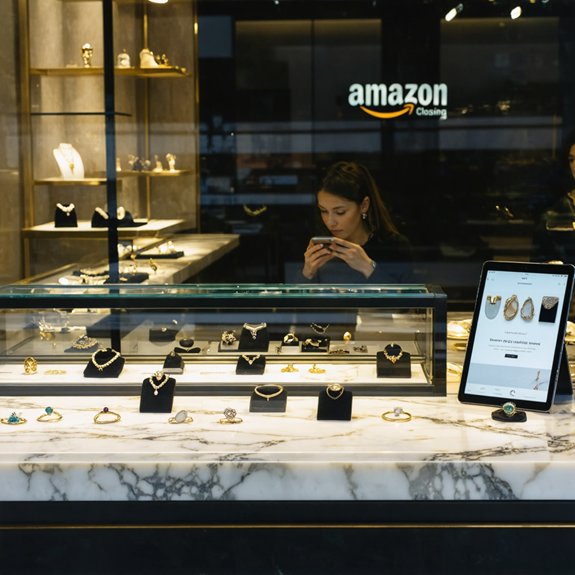The U.S. retail jewelry industry faces significant challenges heading into 2025, marked by a 2.8% market decline and widespread store closures. Lab-grown diamonds now dominate with 53% market share, causing natural diamond prices to drop by 12.34%. Independent jewelers struggle with succession planning, as 83% of owners are over 50 and lack viable shift strategies. Online competition intensifies, yet only 34% of traditional jewelers have implemented e-commerce capabilities. Consumer spending shifts toward travel and experiences further pressure the industry, as mall traffic continues to decline. These trends signal fundamental changes reshaping the future of jewelry retail.
Article Contents
Main Highlights
- Retail jewelry industry faces a 2.8% decline with 226 store closures in Q2 2024, marking significant market contraction.
- Lab-grown diamonds dominate 53% of market share, causing natural diamond prices to drop 12.34% and sales to plummet 50%.
- Succession planning crisis looms with 83% of owners over 50 and only 12% generating sufficient revenue for viable succession.
- Online competition intensifies while 66% of jewelers lack e-commerce capabilities, despite growing digital consumer preferences.
- Mall-based jewelry retailers struggle with declining foot traffic as regional mall vacancy rates reach 11.4%.
Market Decline and Store Closures
Across the United States, the retail jewelry industry is experiencing a significant downturn, with the number of retailers dropping by 2.8% to 17,554 in 2023. This decline reflects a broader trend that has persisted for more than two decades, indicating fundamental shifts in consumer preferences and market dynamics. Similar to major retailers like Macy’s considering store reductions, the jewelry sector faces mounting pressure to optimize its physical presence.
The impact of this downturn became particularly evident in the second quarter of 2024, when 226 jewelry businesses closed their doors – a 30% increase from the same period in 2023. Although 37 of these closures resulted from mergers or takeovers, the majority ceased operations for other reasons, highlighting the challenging business environment. The wholesale trade sector saw 3,305 firms remaining active, contributing to the industry’s overall contraction.
The industry’s transformation is further highlighted by the decreasing number of new businesses, with only 83 jewelry ventures launching in Q2 2024 compared to 116 in 2023. Luxury watch brands are imposing stricter retail requirements, forcing jewelers to make substantial investments in showrooms and inventory.
This ongoing contraction has prompted many established retailers to investigate retail innovation strategies, particularly in response to changing shopping patterns and reduced walk-in traffic following the Covid-19 pandemic.
The total number of active jewelry companies has fallen to 22,760, marking a 3.6% decrease from the previous year and signaling the need for strategic adaptation within the industry.
Rising Impact of Lab Diamonds
The swift ascent of lab-grown diamonds presents a mounting challenge for traditional jewelry retailers, with these synthetic substitutes now commanding over 53% of the diamond market.
Natural diamond sales have experienced a significant downturn as consumers increasingly opt for lab-grown diamonds, which typically cost 40-50% less than their mined counterparts. Natural diamond prices saw a steep 12.34% decline in April 2024, reflecting the market’s shifting dynamics. Millennial and Gen Z consumers are driving this shift with their strong preference for eco-friendly and ethical products. Major retailers like Pandora and Swarovski are capitalizing on this trend by launching dedicated lab-grown diamond collections.
Although lab diamonds offer higher profit margins of 60-65% compared to natural diamonds’ 40-45%, retailers must sell more than four lab-grown pieces to match the revenue from a single comparable natural diamond sale.
Lab Diamond Price Advantage
Lab-grown diamonds have transformed the jewelry market with their striking price advantage, capturing 53% market share by February 2024—up from just 11% in 2020. This significant shift reflects changing consumer preferences, particularly among younger buyers who prioritize lab diamond sustainability and cost-effectiveness.
With prices now up to 90% lower than natural diamonds, lab-grown stones offer a compelling substitute for value-conscious shoppers. Natural diamond retailers face mounting pressure as wholesale prices decline by up to 35% amid weakening demand. Recent data shows lab diamonds have experienced a 36.01% price drop in the past year alone. Traditional diamond producers remain reluctant to adapt to these market changes.
The price differential continues to widen as technological advances in CVD production and economies of scale drive costs down by 20-30% over the past two years. This trend has particularly resonated in emerging markets like the USA and India, where consumers increasingly choose lab-grown diamonds for engagement rings and fine jewelry.
Nearly half of all engagement ring stones sold in the US during 2023 were lab-grown, compared to just 12% in 2019. Although these synthetic diamonds don’t retain value like natural stones and lack a robust resale market, their initial affordability and eco-friendly appeal make them an increasingly attractive choice for modern consumers pursuing both quality and value.
Natural Diamond Sales Drop
Within the past two years, natural diamond sales have experienced an extraordinary decline, with global demand plummeting by approximately 50% due to fierce competition from synthetic substitutes. This striking shift has particularly affected major industry players, with De Beers anticipating a 50% revenue decrease as India’s net polished exports face a stark 49% reduction through 2024.
Market trends indicate a clear bifurcation emerging in the diamond industry, as natural diamonds increasingly become exclusive to wealthy consumers as synthetic options capture the low- and middle-income segments. The post-COVID luxury boom’s cooling effect has further intensified this decline, creating significant challenges for traditional retailers. The appeal of synthetic diamonds is largely driven by their 40-70% lower pricing compared to mined diamonds, making them an increasingly attractive choice for consumers. Retailers are finding synthetic diamonds particularly profitable, with some achieving profit margins exceeding 1,200% on certain pieces.
Key indicators of this transformation include a 55% decrease in US net polished imports for diamonds over 0.50 carats, reflecting changing consumer preferences and market dynamics.
The natural diamond industry’s future appears increasingly niche-focused, as younger generations embrace sustainable options and improved production technologies make lab-grown diamonds more accessible. This structural change in the market requires jewelry retailers to fundamentally reassess their business strategies and adapt to evolving consumer demands. One significant aspect of this shift is the impact on petra diamonds financial strategy, as they navigate the market’s changing landscape. With younger consumers prioritizing ethical and sustainable practices, petra diamonds may need to reevaluate their sourcing and production methods to remain competitive. By aligning their business practices with shifting consumer values, petra diamonds can position themselves for long-term success in the evolving natural diamond industry.
Consumer Shift Toward Travel
Surging travel demand has created significant headwinds for the U.S. retail jewelry industry, as consumers increasingly prioritize experiences over material possessions. The U.S. Travel Association forecasts international travel spending to reach $183 billion, indicating a substantial shift in consumer travel preferences and experiential spending patterns that could impact jewelry retailers.
This transformation in consumer behavior is evident in multiple trends. With domestic travel expected to surpass pre-pandemic levels by 2025, Americans are rediscovering local experiences and outdoor adventures. Understanding target demographics through rigorous market research has become crucial for jewelry retailers adapting to this shift. Budget-conscious travelers are increasingly choosing more affordable destinations closer to home, with 37% of Americans scaling back travel budgets for local holidays. The rise in virtual consultations has made it harder for jewelry retailers to maintain the personal connection traditionally established in stores.
The shift is particularly notable as 56% of live music enthusiasts express willingness to travel internationally for events, whereas sports tourism continues to grow. Furthermore, 83% of travelers now prioritize sustainable travel choices, reflecting a broader change in consumer values.
The jewelry industry, which benefited from redirected travel budgets during the pandemic with 70% of consumers channeling funds toward meaningful purchases, now faces challenges as travel rebounds.
This return to experiential spending represents a significant threat to jewelry retailers, who must adapt to changing consumer preferences as they maintain their market position in an increasingly competitive environment.
Mall Traffic Recovery Struggles
In spite of targeted revitalization efforts, major U.S. shopping malls continue to face significant foot traffic challenges, with mixed recovery patterns emerging across different retail centers.
Although some locations like Mall of America have shown promising growth with an 11% increase in visitors, others like Southdale Center and Galleria Edina continue to struggle with declining numbers. Analysts predict that up to 45,000 retail stores could close, further impacting mall performance.
Mall engagement strategies have evolved to combat these challenges, focusing on transforming traditional retail spaces into dynamic community hubs. Recent data shows that vacancy rates in regional malls reached concerning levels of 11.4%.
Centers implementing experiential retail trends, such as Rosedale Center and Burnsville Center, have seen notable successes through creative approaches. These include developing food halls, adding entertainment venues, and creating mixed-use spaces that serve diverse community needs.
The Mall of America demonstrated the power of entertainment-focused strategies when its DJ Marshmello event drew over 5,000 fans.
The path to recovery reflects a fundamental shift in how malls operate, with many now incorporating non-retail tenants like healthcare facilities and educational centers.
Success increasingly depends on adapting to changing consumer preferences through omnichannel integration and technology adoption.
Those malls investing in experiential offerings and community-focused amenities are showing the strongest signs of recovery, whereas those maintaining traditional retail models continue to face declining foot traffic.
Competitive Price Pressures

Price wars in the retail jewelry sector have intensified significantly, with major retailers and independent jewelers facing mounting pressure on profit margins.
Market data reveals concerning trends, with independent jewelers experiencing a 3% decline in gross sales during early 2024, as industry giant Signet Jewelers reported a steeper 9.4% drop in sales to $1.5 billion.
The emergence of synthetic diamonds and increased pricing transparency has fundamentally altered the competitive environment, forcing retailers to adapt their strategies. The industry has witnessed over 70% of consumers switching from natural to synthetic diamonds in stores.
Signet’s average transaction value fell 1.6% to $552, as Brilliant Earth saw a 12% decrease in average order value. These shifts highlight the industry’s struggle to maintain profitability amid heavy discounting and changing consumer preferences.
The jewelry industry has experienced remarkable historical growth, reaching a peak revenue of $275 billion in 2019 before recent market challenges emerged.
To survive in this challenging environment, jewelers are focusing on competitive differentiation through unique selling propositions and improved digital presence. The Asia-Pacific region now dominates global fine jewelry sales, accounting for 45% of the market.
The industry is moving toward a more branded, digital-first approach, with online fine jewelry sales expected to reach 18-21% of the global market by 2025.
Success will increasingly depend on retailers’ ability to balance competitive pricing with distinctive value propositions that resonate with today’s price-conscious consumers.
Independent Jeweler Succession Challenges
The aging demographic of jewelry store owners, with 83% over age 50, has created a significant knowledge transfer gap as younger generations show limited interest in taking over family businesses.
With 48% of jewelers lacking succession plans or intending to close upon retirement, the industry faces an unprecedented challenge in preserving its future.
Modern succession challenges extend beyond expertise transfer to considerable financial barriers, as the capital investment required to acquire and modernize existing jewelry stores often exceeds the borrowing capacity of potential young buyers. The lack of proper digital skill training among current retail staff further complicates the transition process. Recent trends show a shift toward higher-priced items in retail sales, making it even more difficult for new owners to maintain adequate inventory levels.
The stark reality is that only 12% of independent jewelers generate sufficient revenue to make them viable candidates for succession or buyout, leaving many owners without clear exit strategies for their businesses.
Generational Knowledge Transfer Gap
Nearly half of all independent jewelers lack a formal succession plan, revealing a crucial generational knowledge transfer gap that threatens the industry’s future.
With over 50% of jewelry store owners aged 60 or older and fewer than 10% in their 30s, the challenge of knowledge retention becomes increasingly significant for the sector’s survival.
The market fragmentation has contributed to the closure of many independent jewelry stores, making industry-wide succession planning even more challenging.
The absence of structured mentorship programs and thorough succession planning has led many jewelry businesses to close their doors permanently.
This gap in knowledge transfer affects both technical skills and important business acumen, making it difficult for the next generation to successfully take over operations.
The situation is further complicated by younger generations’ hesitation to enter the industry, citing concerns about work-life balance and the substantial capital investment required.
To address these challenges, jewelry businesses must implement robust succession strategies that include clear timelines, defined roles, and structured knowledge transfer processes. Statistics show that only three percent of family businesses survive to the fourth generation.
Cross-generational collaboration is crucial, combining traditional craftsmanship with modern business practices.
External expertise can provide valuable guidance in developing these succession plans, safeguarding the preservation of both technical skills and business wisdom for future generations.
Capital Investment Barriers Today
Investment hurdles continue to obstruct generational changes in the jewelry retail sector, with financial barriers posing significant challenges for potential successors. The industry benchmark requiring a minimum of $1 million in gross revenue for viable succession creates a substantial threshold for investment readiness, whereas businesses generating $2 million demonstrate especially higher stability and growth potential.
Unfortunately, only 12% of independent jewelers achieve this higher revenue mark. Current data shows that average annual earnings of $55,903 for independent jewelers further highlights the profitability challenges.
Credit accessibility remains a vital obstacle for younger individuals pursuing to enter the jewelry retail market. The substantial capital requirements for business acquisition often exceed the borrowing capacity of next-generation entrepreneurs, who typically lack the established credit history necessary for securing traditional bank loans.
This financial gap is further complicated by increasing operational demands, particularly from luxury watch brands requiring significant investments in showroom improvements and display spaces.
As established jewelers approach retirement age, the combination of these capital barriers and stringent financial requirements creates a concerning scenario for industry sustainability, potentially leading to a decrease in independent jewelry retailers across the United States.
Exit Strategy Market Realities
Facing a pivotal crossroads, independent jewelers confront sobering succession realities as demographic shifts and market pressures reform the industry’s future. With 83% of family-owned jewelry businesses led by owners over 50 and nearly half exceeding age 60, the industry stands at a vital juncture in its generational shift.
The statistics paint a challenging picture for succession planning within these family enterprises. Only 40% of family-owned businesses successfully transition to a second generation, with mere 13% reaching third-generation ownership. The industry’s total of 70,065 businesses faces mounting pressure to address succession challenges.
Further complicating matters, 26% of jewelry businesses operate without a formal succession plan, whereas 22% anticipate either selling or closing their doors. Family dynamics play a significant role in these changes, requiring careful consideration alongside operational factors.
Financial viability presents another major hurdle, as businesses need to generate at least $1 million in gross revenue to be considered viable for succession or buyout.
With only 12% of independent jewelers reaching the more sustainable $2 million threshold, many face limited alternatives for securing their legacy continues beyond their tenure.
E-commerce Competition Intensifies

The surging growth of online jewelry sales has fundamentally disrupted the traditional retail jewelry environment in the United States. With e-commerce market share climbing to 29.2% in 2023 and Top 1000 category sales reaching $6.25 billion, digital marketing has become crucial for survival in this evolving setting.
Local jewelers face mounting pressure, as 40% now view e-commerce websites as their primary competitive threat, yet only 34% have implemented online selling capabilities. The jewelry market shows signs of strength with market value reaching $20.2 billion in 2018. Leading online retailer WatchBox grew 7.8% in 2023, setting the pace for digital transformation. The shift to online platforms accelerated dramatically as jewelry sales experienced an 82% decline during the early pandemic stages.
The transformation is largely driven by younger consumers, with nearly half of online jewelry purchasers being 34 or younger. This demographic shift demands improved consumer engagement through multiple digital touchpoints, including AR/VR technologies that have boosted conversion rates by 28%.
The direct-to-consumer model continues to gain traction, as traditional retailers struggle to adapt their business strategies to meet online expectations.
Looking ahead, online fine jewelry sales are projected to represent 18-21% of the total market by 2025, highlighting the urgent need for traditional jewelers to establish robust digital presences.
Those failing to embrace e-commerce risk losing significant market share in an industry increasingly dominated by digital-first competitors.
Our Final Thoughts
The persistent pressures plaguing the retail jewelry sector signal significant structural shifts heading into 2025. Market maturity, mounting mall challenges, and modern consumer migration toward memorable experiences over material purchases present significant problems. Lab-grown diamonds’ striking disruption, digital competition’s determined advancement, and legacy jewelers’ leadership lapses collectively contribute to concerning conditions. These revolutionary trends suggest sustained struggles ahead for traditional jewelry retail, necessitating strategic adaptation for survival.




